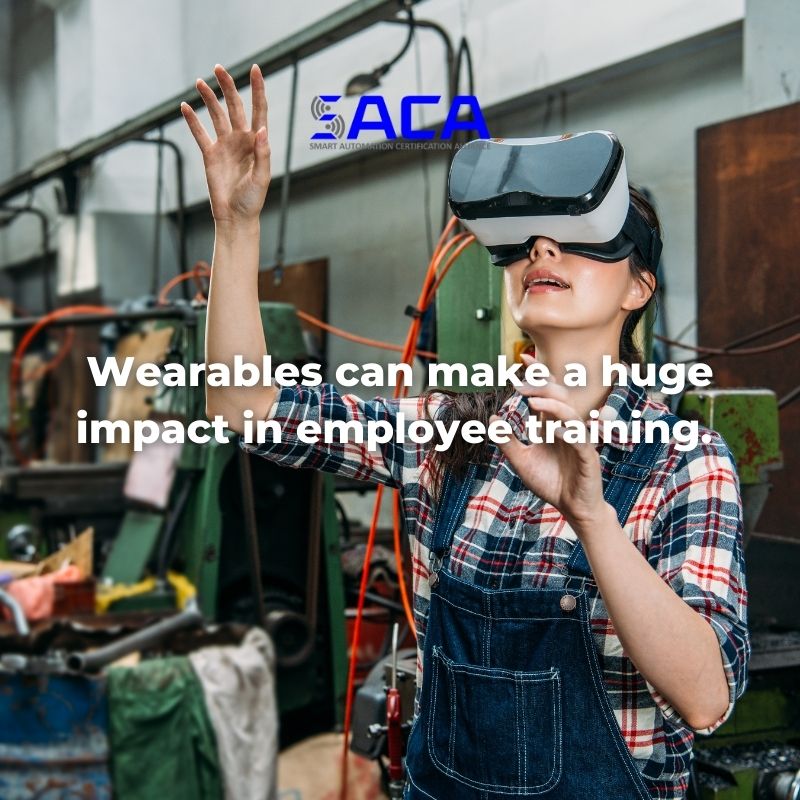Wearables Leverage Smart Technologies to Improve Safety and Productivity
Long, long ago, in a land that time has forgotten, there used to live human beings who were not connected to the Internet 24/7. They did not carry a telephone, camera, calculator, newspaper, encyclopedia, radio, calendar, clock, map, photo album, and book simultaneously on their persons.
What a dumb world they lived in! Does that sound harsh? Maybe, but what else would you call the opposite of the “smart” world we live in today? The example above seems silly, but 30 years ago the thought of having access to all those things — and more! — in the palm of your hand would’ve seemed just as crazy.
Today, smart technology is everywhere you look. It’s in our smartphones and other electronic gadgets. It’s in our homes and schools. We’re even wearing smart technology these days. From smart watches to fitness trackers, “wearables” are more popular than ever.
While many of the first uses of smart technologies in wearables focused on improving personal physical fitness, clever developers have created new devices for the workplace. If your workplace doesn’t already use some form of wearables for employees, it likely could in the near future.
In this article, we’ll take a closer look at the important role wearables are playing in today’s advanced manufacturing and logistics workplaces. Read on to learn how smart technologies are making employees safer and workplaces more productive and efficient.
What are Wearables?
According to Investopedia:
“Wearable technology, also known as ‘wearables,’ is a category of electronic devices that can be worn as accessories, embedded in clothing, implanted in the user’s body, or even tattooed on the skin. The devices are hands-free gadgets with practical uses, powered by microprocessors and enhanced with the ability to send and receive data via the Internet.”
When you hear the word “wearables,” smart watches and fitness trackers you wear around your wrist are probably the first devices that come to mind. However, as the definition above reveals, developers are becoming more and more creative when it comes to wearable technology.
Having access to your smartphone features on your watch and keeping track of the number of steps you’ve taken both have obvious benefits. But what about in the workplace? Is there really a need for these types of devices on the job?

After all, aren’t robots taking over anyway? Will there even be factory jobs for people in the future? Won’t it just be all automation? While automation certainly plays an increasingly important role in modern industrial facilities, the robot takeover has been greatly exaggerated.
Sure, some low-skill positions have been eliminated by the use of robots and other automated technologies, but there are still hundreds of thousands of open manufacturing jobs that employers are having a hard time filling. Moreover, the more automation there is, the more highly-skilled workers are needed to operate, maintain, troubleshoot, and repair that equipment.
As Jessica Lin notes in a Forbes article, “we have 30 to 50 years until we reach a world of full automation. It’s very hard to replicate the flexibility, speed and dexterity of a person. That’s why Amazon has a lot of robots, but still hired more than 425,000 people this year.”
People remain key assets today more than ever. Because of their importance, employers are now leveraging smart technologies in the form of wearables designed to protect and improve the everyday work experience for employees.
How Can Wearables Improve Safety in the Workplace?
Workplace safety: it’s an issue so fundamental that we tend to overlook its importance when we focus on seemingly bigger issues, such as improving efficiency and productivity via advanced automation technologies. However, employers would be wise to engage their employees in keeping safety first and foremost in their minds.
After all, workplace injuries greatly affect the bottom line. In her article, Lin highlights the impact felt by businesses as a result of work-related injuries:
“Every year in the U.S., nearly three million workers are injured on the job. The most frequent injury across this workforce are musculoskeletal injuries, which are often caused from cumulative wear and tear of the body, along with improper body mechanics. Musculoskeletal injuries are on average the longest injury to recover from, and usually the most debilitating in the long term. These injuries have huge financial implications – $170 billion was lost on workers’ compensation in 2018, and in an industry with high turnover, this means companies are spending unnecessary time and money to replace and retain employees.”

As Pat Stoik advises in an Industry Today article, “Employees are the best and first line of defense against safety incidents, which always disrupt business in some way…A well-executed safety culture not only ensures employees’ well-being, but also prevents disruptions and delays, saving companies money.”
How can companies accomplish this? One answer for food and beverage giant PepsiCo is the use of wearables. As Max Garland points out in a Food Dive article, “Frito-Lay’s need to fill 5,000 positions across its U.S. manufacturing sites to meet heightened demand has underscored the importance of keeping frontline employees healthy and able to work. Using wearables is one way to do that.”
According to Garland, “Thousands of workers at 34 Frito-Lay manufacturing and distribution centers cut back on improper lifting and posture when using Kinetic’s Reflex wearable device… [that] recognizes improper moving and lifting techniques and alerts the user with a vibration.”
In her article, Lin notes that Kinetic is “a New York-based company building wearable technology to reduce workplace injuries for industrial workers: everyone from last mile delivery drivers (who make up 40% of Kinetic wearers) to shipping, construction, manufacturing, and logistics operators.”
To date, companies using Kinetic’s wearables have experienced great success. As Garland notes, “[d]ata from the devices allowed management at Frito-Lay’s Kern Plant in California to determine what areas of the facility frequently featured improper movements…[and] to retrofit equipment and modify workspaces to reduce worker risk…reducing strain and sprain injuries by 19% YoY.”
Lin adds, “Since launching in 2014, Kinetic can now be found on tens of thousands of workers across the country, and customers include Pepsi, Iron Mountain, among others. On average, Kinetic reduces injury rates by 54%, lowers lost work days by 88%, and enables managers the insights necessary to create a safer working environment.”
Kinetic is not the only company producing wearable devices for the workplace. Many other companies have developed wearables that can improve worker safety in a variety of ways. For example, in a JourneyApps Blog article, author Leon van Heerden notes, “Wearables can now tell you which surfaces are too hot to touch, when machinery is malfunctioning, or even when conditional hazards, like spilled fluids, are present.”
Moreover, he points out that wearables can also “warn workers, and their management, when someone is physically overworking themselves and that they need to take a break before they become fatigued and make a mistake that can lead to an injury.” Importantly, improved safety isn’t the only significant impact wearables are making in the industrial workplace.
How Can Wearables Increase Productivity in Industry?
Reducing injuries and time away from the job positively impacts the bottom line, but businesses that have adopted wearables in the workplace have also learned how to use them to increase efficiency and drive greater productivity.
For example, van Heerden writes, “There are many use cases where businesses can improve efficiency: technicians can be connected to vital information about the equipment they are servicing; field workers can be given access to information on inspections; employees can be tracked in challenging environments.”
He adds, “Workers in the field, factory, or warehouse can now access information through wearables, often replacing a touch interface with one that is voice-driven, allowing their hands to remain free for the job at hand.”
Another area in which wearables can make a huge impact is employee training. General Motors uses Google’s Glass to train new hires — hands-free and on-the-go — on an active production line. Alternatively, wearables can also be used for both “immersive task simulations” and “three-dimensional training on how various products work through the help of HMTs and assisted reality,” according to van Heerden.

Will the trend of wearables in the industrial workplace continue? Authors like van Heerden believe it will: “Wearable technology will continue to grow within the industrial sector as it has clearly demonstrated its benefits. Productivity is increased, safety is improved, errors are reduced and training is more meaningful when wearable technology is incorporated.”
Recent research supports his view. Gartner predicts “total wearable sales of $81.5 billion in 2021, while a report by Research and Markets predicts the industrial wearable devices market will exceed $2.78 billion by 2024, increasing annually at a rate of 9.2%.” The same appears to hold true for the logistics industry: “a 2018 study logistics association MHI predicted that within five years, 70 percent of warehousing and distribution facilities would adopt wearables.”
Industry would not be seeing these benefits without the cooperation of willing employees. In his article, Garland notes that employees have readily embraced the use of wearables in the workplace, because “it empowers them to talk with management about how a facility could be improved.” As their behavior in the workplace changes in response to data gathered from wearables, employees can initiate conversations that lead to meaningful changes that improve their jobs.
Contact SACA to Learn More about Smart Automation Certifications
Wearables are just one of the many forms of new advanced, “connected” technologies that characterize what’s commonly known as Industry 4.0. These technologies, as a group, also go by a variety of monikers, including Smart Factory and the Industrial Internet of Things (IIoT).
Today’s workers need more advanced technical and technological skills than ever before. Unfortunately, there aren’t enough workers with these skills to fill the many roles available today, creating what is known throughout industry as the “skills gap.”
How can modern businesses find the workers they need? How will educational institutions teach the skills modern industry needs? These are questions that demand answers, and one promising solution is the development of industry-standard certifications that focus on connected-systems skills. The Smart Automation Certification Alliance (SACA) sits at the forefront of the effort to certify students and workers who demonstrate the required knowledge and hands-on smart automation skills employers so desperately need. To learn more about Industry 4.0 certifications and how SACA can help both educational institutions and industry employers begin the task of bridging the Industry 4.0 skills gap, contact SACA for more information.

- Published in News



